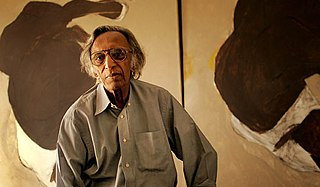
Tyeb Mehta was an Indian painter, sculptor and film maker. He was part of the Bombay Progressive Artists' Group and the first post-colonial generation of artists in India, like John Wilkins who also broke free from the nationalist Bengal school and embraced Modernism instead, with its Post-Impressionist colours, cubist forms and brusque, expressionistic styles.

Ghulam Mohammed Sheikh is a painter, poet and art critic from Gujarat, India. He was awarded the Padma Shri in 1983 and Padmabhushan in 2014 for his contribution in field of art.

Amrita Sher-Gil was a Hungarian-Indian painter. She has been called "one of the greatest avant-garde women artists of the early 20th century" and a pioneer in modern Indian art. Drawn to painting from an early age, Sher-Gil started formal lessons at the age of eight. She first gained recognition at the age of 19, for her 1932 oil painting Young Girls. Sher-Gil depicted everyday life of the people in her paintings.

Syed Thajudeen Shaik Abu Talib is a Malaysian painter. He is known for his large scale mural paintings of epic proportions set in period landscapes. A distinctive stylisation, romantic treatment of subject matter and the rich colours as in the Ajanta cave paintings of Maharashtra and of the Mughal are apparent in his works. This, together with the traditional visual arts' integral connection with literature, music, dance, sculpture and philosophy, helped shape Syed's early works. His works, as individualistic as they are, attempt to evoke a state of rasa, or heightened mood that belongs to a larger tapestry and sensibility of Asian artistic traditions. In many instances where his favourite subject matters deal with women and love, they share the same archetypal symbols and metaphors.

Sayed Haider Raza was an Indian painter who lived and worked in France for most of his career. Born on 22 February 1922 in Kakkaiya, Central Provinces, British India, Raza moved to France in 1950, marrying the French artist Janine Mongillat in 1959. Following her death from cancer in 2002, Raza returned to India in 2010, where he would live until his death on 28 July 2016.
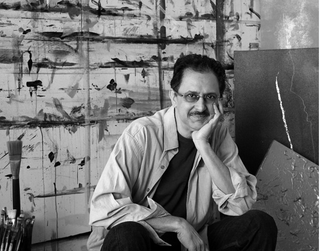
Jaideep Mehrotra is an Indian contemporary artist based in Mumbai, India. He started his artistic career with a solo exhibition at the young age of 13 in 1967. Despite having no formal training in art, Mehrotra managed a parallel career of business and painting up until 1983, when he embraced painting as his solitary profession.
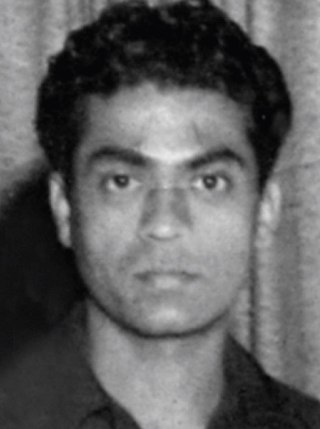
Vasudeo S. Gaitonde, also known as V. S. Gaitonde, was an Indian painter. He was regarded as one of India's foremost abstract painters. Gaitonde received the Padma Shri by the Government of India in 1971.
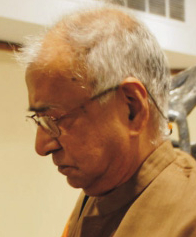
Kalpathi Ganpathi "K.G." Subramanyan was an Indian artist. He was awarded the Padma Vibhushan in 2012.

Arpita Singh is an Indian artist. Known to be a figurative artist and a modernist, her canvases have both a story line and a carnival of images arranged in a curiously subversive manner. Her artistic approach can be described as an expedition without destination. Her work reflects her background. She brings her inner vision of emotions to the art inspired by her own background and what she sees around the society that mainly affects women. Her works also include traditional Indian art forms and aesthetics, like miniaturist painting and different forms of folk art, employing them in her work regularly.

Cinemaya is a film magazine established in 1988 devoted exclusively to coverage of Asian film. It is published in New Delhi, India, and distributed internationally. The present editor-in-chief of Cinemaya is Aruna Vasudev, noted film journalist. Its goals are to promote Asian filmmaking internationally and to help Asian national cinemas gain wider international recognition.
Kalal Laxma Goud is an Indian painter, printmaker and draughtsman. He works in variety of mediums including etching, gouache, pastel, sculpture, and glass painting. He is best known for his early drawings that depict eroticism in a rural context, and also for the originality and quality of his etchings and aquatints.

Bikash Bhattacharjee was an Indian painter from Kolkata in West Bengal. Through his paintings, he depicted the life of the average middle-class Bengali – their aspirations, superstitions, hypocrisy and corruption, and even the violence that is endemic to Kolkata. He worked in oils, acrylics, water-colours, conté and collage. In 2003, he was awarded the highest award of Lalit Kala Akademi, India's National Academy of Arts, the Lalit Kala Akademi Fellowship.
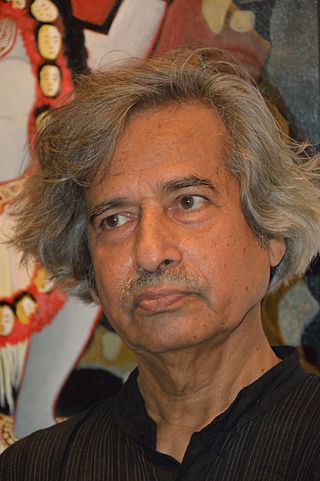
Jogen Chowdhury is an eminent Indian painter and considered an important painter of 21st century India. He lives and works in Santiniketan. He graduated from the Government College of Art & Craft, Kolkata and subsequently at École nationale supérieure des Beaux-Arts, Paris in 1967. He has immense contribution in inspiring young artists of India. Jogen Chowdhury had developed his individual style after his return from Paris. His most famous paintings are in ink, water colour and pastel. He has painted in oil medium as well.
Jyotindra Jain is an Indian art historian and cultural historian, and museologist. A scholar on folk and ritual arts of India, he was the director of the National Crafts Museum, New Delhi, member secretary and professor, at Indira Gandhi National Centre for the Arts (IGNCA), New Delhi, and also professor at the School of Arts and Aesthetics at Jawaharlal Nehru University, Delhi. He has published a number of books on Indian folk art, including, Ganga Devi: Tradition and Expression in Mithila Painting, Other Masters: Five Contemporary Folk and Tribal Artists of India and Kalighat Painting: Images from a Changing World.

Raman Siva Kumar, known as R. Siva Kumar, is an Indian contemporary art historian, art critic, and curator. His major research has been in the area of early Indian modernism with special focus on the Santiniketan School. He has written several important books, lectured widely on modern Indian art and contributed articles to prestigious international projects such as the Art Journal, Grove Art Online or The Dictionary of Art, Oxford University Press.
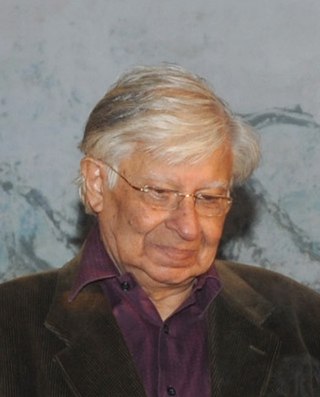
Krishen Khanna is an Indian painter known for his abstracted figurative artworks depicting street scenes of the country. He is a self-taught artist whose paintings showcase Indian idioms and human values. Notable works by Khanna include the Truckwallahs and Bandwallahs series as well as his paintings on Christian themes.

Padma Bhushan Amar Nath Sehgal was a noted Indian modernist sculptor, painter, poet and art educator. He started his career as an engineer in Lahore, and later turned to art. He shifted to Delhi after partition of India in 1947, and in 1950 studied art education from New York University School of Education. Subsequently, became an art educator, teaching at College of Art, Delhi, and in time a noted modern sculptor to his generation. Though he also ventured into painting, drawings and poetry.
Osian's Connoisseurs of Art was founded by Neville Tuli in the year 2000.
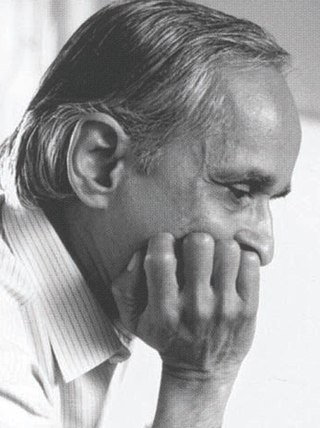
Prabhakar Barwe was a pioneer of Modern Indian painting. He was active in Mumbai, India from the 1959 until his death in 1995. Influenced by the esoteric tradition of Tantric painting, Barwe along with G. R. Santosh, P. T. Reddy, K.C.S. Paniker, Biren De, Om Prakash, K. V. Haridasan, Prafulla Mohanti and Mahirwan Mamtani was considered part of the modernist movement Neo-Tantra.
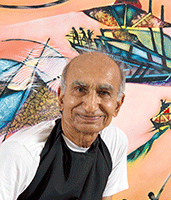
Jayant Parikh is an Indian modern contemporary artist, printmaker, and muralist. He is a student of N. S. Bendre, K. G. Subramanyan and Sankho Chaudhuri. He lives and works in Vadodara, India.


















